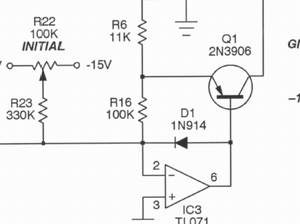The VCA-1 Project
A Versatile, Uncomplicated Workhorse VCA For Your Synthesizer
As synthesizer modules go, the modest unassuming VCA often gets the short shrift. You know, it gets lumped in there as one of the "vanilla" modules. It's something you may need, but it doesn't get you as pumped up as, say, that multi-orthogonal-hexa-franisttater module everyone is raving about. The VCA, on the other hand is that steering wheel you need in order to drive your car.
If you're one of those people that regard the VCA as merely necessary, or even worse, boring, please allow me to disabuse you of that notion. The VCA is perhaps one of the most powerful modules in your system. In fact, for me, if there's one element that qualifies a modular as truly "powerful", it's the number of VCAs that system has. Sure, you may have filters out the ying-yang and VCO's up the wazoo, but how many truly inventive ways are at your fingertips for controlling them? How are you set for voltage controlled routing and mixing of those exotic signals? A modular so densly packed with filters and VCOs so that there is no room for some VCAs and mixers is the synthesizer world's version of the muscle-bound weightlifter that has trouble tying his shoes.
Of course, VCAs provide that all important parameter of voltage controlled amplitude so necessary to analog synthesis. But, they also allow you to rig up such cool things as dynamic depth modulation, delayed vibrato, audio rate amplitude modulation, voltage controlled resonance, location modulation (using one of those new-fangled quadrature function generators I've read about), voltage controlled mixing, and, of course, modulation of the modulation of the modulation of that self running noodle.
Looking at it quite simply, that humble little guy is, for all practical purposes, literally a voltage controlled pot. Anything that is voltage controlled, you can control with this voltage controlled pot. If you've ever stood next to your modular, cranking a pot up and down to accentuate that patch you've got running, and wondered why someone didn't automate that function - well, they did. They made the VCA.
Enter the Thomas Henry VCA-1. Thomas is quite humble about it, saying it's an appropriate VCA for musical purposes, but not in a league with the CEMs and SSMs of this world. This may be true (after all, those devices are fine tuned for this kind of thing) but I think he underestimates it a bit - I've been using it now for the better part of this summer, and it works just fine in my patches. There's very little thump and I haven't had any problem with noise or hiss with it. And, of course, it has that nearly-patented bang-for-the-build punch Thomas is famous for. If you want a passel of VCAs, I can't think of a more appropriate design to use. Of course, you'll need CA3080s for that, but they're still around.

VCA-1 Documentation
You can click the schematic icon below to download a 2.1 MB Zip file containing everything you need to build the VCA-1. This includes the schematic, PCB layout, component location, parts list, panel layout, and drill pattern.
VCA-1 Circuit Theory
First of all, let's look at the goodies. Let's start with the signal input. The first thing you may notice is there are three signal inputs on Thomas' schematic. Right off the bat, there's an application that you may not have expected; the VCA-1 not only is a VCA, but it can serve as a three input mixer as well! So, even if the module is not being used as a VCA, you can still use it as a signal mixer. You can adjust the level of these signals individually and either manually, or through voltage control, adjust the overall amplitude of this mixture of signals. How cool is that? You could add more signal inputs by tying them through a 100K resistor to the common node at pin 2 of, or reduce the number of inputs there, depending on your needs.
The second thing you may notice is that each input has an AC/DC switch. As is implied by the name, these switches allow the operator to select either AC or DC coupling individually for each input.
DC coupling is a powerful feature of any VCA; this allows you to control slow moving or static control signals. Say you have the output of a sample and hold passing through your VCA - you can then control the level of that signal with an LFO, or a smoothed voltage (or stepped voltage) from another sample and hold.
AC coupling an input allows one to eliminate any DC offset in the input signal. Normally this is used to get rid of the DC offset in an audio signal; in that case, a DC offset may cause a 'thump' in the VCA as the VCA is modulated by sharp transients such as those provided by envelope generators. AC coupling removes that annoyance.
Moving on, we see that R22 serves as the initial level control. By adjusting R22, you manually set the output level of the VCA. The control voltages act on this initial level; for example, if you're using a unipolar positive signal (IOW a signal that begins at 0V and moves positive in voltage) such as an envelope generator, you would adjust R22 so that the output of the VCA was silent while the envelope generator was off (at 0V). Conversely, if you wanted the VCA to go silent when an inverted signal that started positive in voltage and "peaked" at a lower voltage, you would set the initial level with the VCA "on", sot that it closed with the negative going signal.
If your desire is to use the VCA to create a quavering tremolo effect using an LFO, you would set the initial control towards the center, so that the VCA was at half output. The bipolar LFO would then increase and decrease the amplitude of the output signal. Of course, for audio rate AM, the same settings would be used.
The initial setting can be altered to provide whatever effect you're looking for while processing either audio or control signals (or both).
Next up, we'll examine the control inputs. The amplitude of the VCA-1 responds linearily with control input. This is fortunate, because most envelope generators are exponential by nature.
Notice there are two control inputs. The Envelope input (J4) is an unattenuated input that allows an envelope generator to control the VCA-1 throughout its entire range.
The Variable CV input (J5) allows you to control how much modulation is applied to the VCA-1. The level is controlled by R21. This is where you get into the fine tuning of controlling the VCA using any type of control or audio signal.
Finally, we arrive at the outputs. Yep, there are two outputs. Max Out (J6) provides the full voltage range of the VCA: 0 to 10 V peak to peak (+/-5V). This output is generally used for patching between modules, as in the control function that I've been beating into the ground. What I really like about this module is J7, Line Out. Now, this one handy little output. It allows ou to interface to the outside world (an amplifier or mixer input) without fear of blowing either the channel input, a speaker, or your eardrums. You can safely patch out fo this jack and control the maximum level of the signal with R4 "Level".
Calibration
Here's how I adjust the offset: Run a square wave of say 100 Hz into the Variable CV. This is probably +/-5V, so set the Atten pot to 50%. You now have +/-2.5V. Dial the Initial control to shift this up to 0 to +5V. The point is, you now have a 0 to +5V square wave modulating the thing. Don't connect anything to the Audio inputs, and connect the Line Out to an amplifier.Now just listen and adjust the offset trim for minimal feedthrough.In short, I find my ears to be much better than test equipment for adjusting this thing.
Sound Samples
First up is a sample Thomas recorded back in the Midwest Analog days (this sample can also be found on the VCO-1 Resources page). In this sample, Thomas demonstrates the MTS-100 Midi to CV converter. The converter is controlling a VCO-1 through the VCA-1.
Here's a sample that uses the VCA-1 to deliver the bass voice to the composition. The sample, entitled "Do You Klee" was recorded using the Thomas Henry VCO-1 through the Mankato Filter which is then patched through VCA-1. Another VCO, an Rene Schmitz VCO3 was used for the "high" voice - this VCO was passed through the Schmitz 2040 clone filter. A third voice consists of the Blacet DSC2000, which is mixed directly with the other two voices. The whole sample was controlled by the Klee Sequencer prototype on breadboard.
The bass Voice is a fairly interesting patch - the triangle wave of the VCO is patched to the mixer module directly in addition to the Mankato/VCA-1 chain. Throughout the sample, the EG controlling the Mankato and VCA-1 is switched between a very short envelope, and a longer envelope. The kick drum type sound heard is this chain under control of the short envelope. The flowing bass line is the triangle wave, and the enunciated bass notes are created by the Mankato/VCA-1.
This next sample demonstrates how a VCA can help to modify a voice by providing a means to implement dynamic depth frequency modulation. The VCO-1 triangle wave is patched through the Mankato filter. The VCO-1 is controlled by the Klee Sequencer, and the Mankato Filter is controlled by both the Klee and an envelope generator triggered by the Klee.
A second VCO, Rene Schmitz's VCO3, has its sine wave patched to the FM input of the VCO-1, through the VCA-1. The VCA-1 is controlled by a second voltage output of the Klee Sequencer. The upshot is, because this voltage varies with each note, the VCA-1 lets more or less of the audio rate sine wave through to modulate VCO-1. The sample first starts with no modulation, and as it progresses, I increase the amount of modulation on VCA-1 by adjusting R21 to allow more of the Klee voltage through to "open up" the VCA.
Finding Parts
Other than the CA3080, all of the parts in the VCA-1 project are quite easily accessible just about anywhere. Even though the CA3080 was discontinued, it's still more or less easy to get if you look in the right places.
If you've read any of my pages, you already know how I feel about Steve Daniels and Small Bear Electronics - they're quite simply the best thing to hit DIY Stompboxes or Synthesizers. They've got the CA3080, and so very much more....
Click the Bear!

For those of you across the pond, if the Bear's too far to go, Banzai Electronics has them listed too!
Banzai Electronics
VCA-1/Thomas Henry Resources
The Electro-Music community hosts the Thomas Henry Designs Forum - a great place to go to learn about all the latest Thomas Henry developments. You'll find a lot of groovy people in that forum, and in the rest of the Electro-Music community as well. It's flat out the best place on the Internet to hang out if you're into electronic music of any genre. Click the Electro-Music icon to get to the Thomas Henry Designs Forum.

Magic Smoke Electronics is your source for all of the great original Thomas Henry cookbooks. As time goes by, they release them one by one, so keep an eye on them! In particular, be on the lookout for the CA3080 Cookbook. Also, this is *the* place to get the awesome TH-201 Mankato Filter.
Click the Magic Smoke icon to be taken away to the land of...errr...Magic Smoke.


